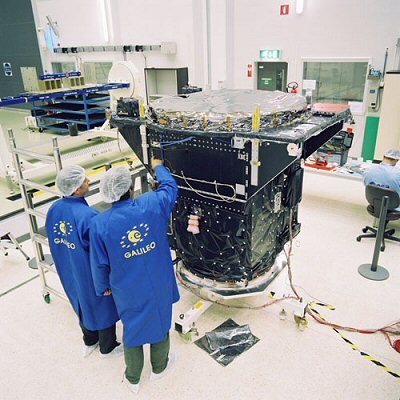Galileo satellite arrives at ESA-ESTEC for testing
One of the two Galileo satellites currently under development,
Two satellites are being developed for the Galileo System Test Bed – Version 2, which will make up the first phase of in the
The primary mission of the first Galileo satellites is to secure the Galileo frequency filings, validate new technologies for operational use, characterise the radiation environment of the medium earth orbits that the operational satellites will occupy and enable experimentation with live Galileo signals.
Galileo is a global navigation satellite infrastructure under civil control. It is a joint initiative of the European Commission and ESA.
The satellite

The
The satellite will carry a payload that will transmit a Galileo experimental signal. Main elements of the payload are:
- An antenna, comprising a phased array of individual L-band elements, illuminating all the visible Earth below the satellite
- Two signal generation units, one able to generate a simple Galileo signal, and the other able to generate more representative Galileo signals
- Two Rubidium atomic clocks
The expected satellite lifetime is two years.
Test campaign

ESA maintains a large centre for the testing of space vehicles and their subsystems at its European Space Research and Technology Centre (ESTEC), located at Noordwijk in The Netherlands. The ESTEC Test Centre has the capability of simulating the conditions that spacecraft will experience during launch and once they are in space. ESA will conduct the
The tests that
- Space environment simulation – the satellite will be placed in ESTEC’s Large Space Simulator (LSS), where its performance in the cold and vacuum of space can be assessed.
- Solar array deployment – the solar arrays will be unfolded to confirm correct functioning of the deployment mechanisms and the systems that keep them stowed during launch.
- Shock and vibration – the spacecraft will be subjected to vibration and mechanical shocks during launch and separation from the launcher. An electrodynamic shaker will simulate this environment to ensure that the satellite can withstand it.
- Acoustic – at lift-off and during the early part of its journey into space, the satellite is exposed to intense noise. The Large European Acoustic Facility will simulate this environment to check that the spacecraft will not be damaged by the noise.
- Electromagnetic compatibility – to ensure that the various spacecraft systems do not affect one another’s correct functioning through radio signals emitted intentionally or by electrical interference
The future
The other of the two Galileo satellites,
The first Galileo launch is scheduled for December this year. The satellite will be carried into space from the Baikonur cosmodrome in Kazakhstan by a Soyuz launcher.















 Germany
Germany
 Austria
Austria
 Belgium
Belgium
 Denmark
Denmark
 Spain
Spain
 Estonia
Estonia
 Finland
Finland
 France
France
 Greece
Greece
 Hungary
Hungary
 Ireland
Ireland
 Italy
Italy
 Luxembourg
Luxembourg
 Norway
Norway
 The Netherlands
The Netherlands
 Poland
Poland
 Portugal
Portugal
 Czechia
Czechia
 Romania
Romania
 United Kingdom
United Kingdom
 Slovenia
Slovenia
 Sweden
Sweden
 Switzerland
Switzerland





























